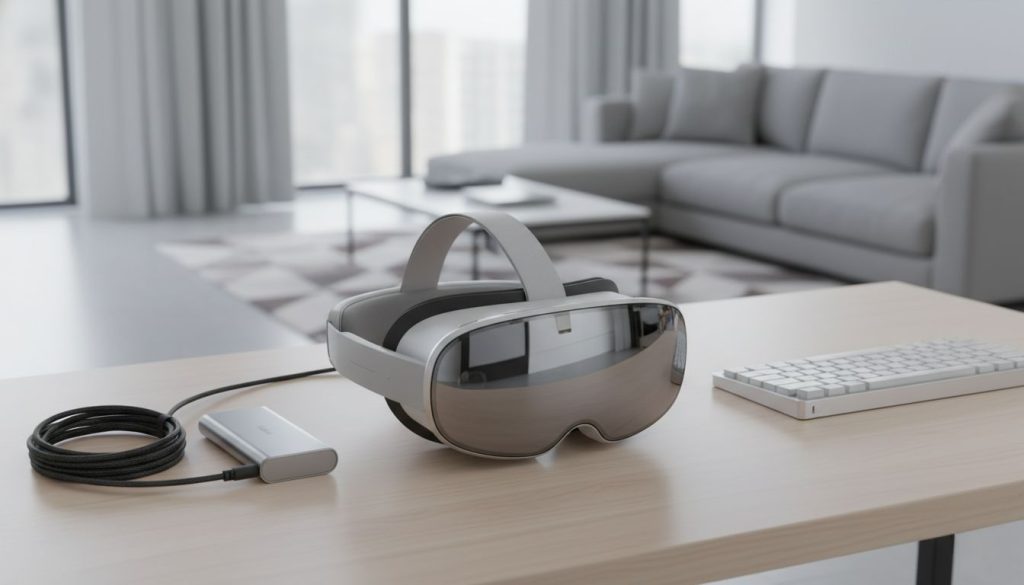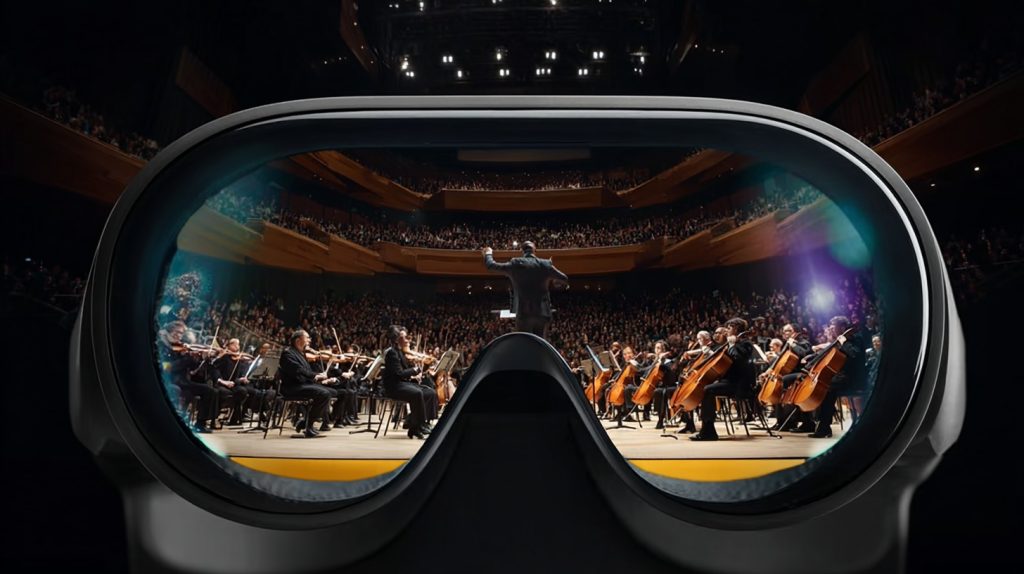
Table of Contents
Samsung Galaxy XR Headset launches into a market still trying to decide whether mixed reality is a revolution or a very expensive detour. At $1,800, the Samsung Galaxy XR Headset arrives as a deliberate shot at Apple’s $3,499 Vision Pro, buoyed by a three-way alliance with Google and Qualcomm and packaged with an AI-forward subscription bundle that tries to turn price into momentum. This is not a hobby. It is Samsung’s attempt to make spatial computing feel less like a gated community and more like a neighborhood you can actually afford to visit.
Samsung Galaxy XR Headset: Price, Partners, Positioning
Samsung’s play is straightforward. Build a credible Vision Pro rival, price it around half, and lean on partners to fill the gaps that hardware alone cannot. The Samsung Galaxy XR Headset runs Android XR, a new Google-led platform, and is powered by Qualcomm’s Snapdragon XR2+ Gen 2. The launch price is $1,799 to $1,800 depending on retailer, with a limited-time bundle that includes a year of Gemini AI Pro, YouTube Premium, and Google Play Pass. That is not trivial window dressing. It is an economic nudge for a category that has struggled to explain itself to everyday users.
For the basics: 4K-per-eye micro‑OLED, hand tracking and eye tracking, high-resolution passthrough, and battery life of roughly two to two and a half hours. In other words, premium components and standard XR trade-offs. The shared DNA with Apple’s approach is obvious, but the price positioning is the point. As Reuters notes, Samsung is explicitly undercutting Vision Pro on cost while standing up a Google–Qualcomm–Samsung axis around Android XR, an open platform meant to lure developers who balk at a walled garden and a $3,499 gate fee.

Price gets attention. AI keeps it. The Samsung Galaxy XR Headset bakes in Gemini at the system level. Ask about a landmark in Google Maps while you are virtually perched above Manhattan and get real-time context plus an option to act. Rearrange virtual workspaces, surface how‑to guidance mid‑game, and summarize videos without juggling apps. This is where Samsung’s pitch diverges from Apple’s for now. Apple’s Vision Pro still feels designed first as a pristine display and second as a computing paradigm. Samsung and Google are trying to invert that formula by making AI the operating layer.
Let’s be candid about the trade. Cloud-first AI means you are sending a lot of what you see and do to servers you do not control. That raises legitimate privacy and governance questions that consumer tech has mostly kicked down the road. A progressive view here is simple. If spatial computing is going to normalize cameras and microphones on your face, the rule of law should not be an afterthought. Strong data minimization, auditability, default opt-outs, and jurisdictional protections matter more in head-worn computing than they did on phones. Samsung and Google have to prove they can meet that bar and not just ship delightful demos.
Pricing Strategy: Undercutting Without Undervaluing
Samsung wants to land in the psychological middle. Not budget, not luxury. At $1,800, the Samsung Galaxy XR Headset is still an expensive purchase, but it narrows the chasm between curiosity and checkout. In tech hardware, price is a language. Undercutting Vision Pro signals that XR can be premium without being precious. Bundling paid services reframes total cost of ownership and helps mask the content deficit that dogs new platforms. Meanwhile, hardware margins in early cycles are rarely the story. Platform lock-in, app revenue splits, and services ARPU are.
This is a playbook as old as the smartphone wars. The difference now is the dependency on generative AI. If Gemini’s ambient assistance becomes the stickiest part of the experience, the subscription becomes the product and the headset becomes the container. That is both smart strategy and a risk. If the cloud stumbles or pricing shifts, usefulness collapses fast.
Consumer Adoption: Who Is This For Right Now
Mixed reality keeps failing the dinner-table test. People know what a better camera is. They understand a faster laptop. Spatial computing still requires a monologue. Samsung’s answer is to aim for practical, bite-size value.
- Big-screen entertainment without a TV.
- Multitasking for knowledge workers who live in browsers and docs.
- Lightweight spatial creation and training at work, where a headset can pay for itself in one pilot.
The Samsung Galaxy XR Headset still has to live with physics. Two hours of mixed use is not a workday. Avatars are still awkward. Controllers are sold separately. And no bundle fixes the blank space where a must-have app should be. But shaving the price and raising the AI ceiling makes the category easier to try and easier to defend.
Market Competition: The New Triangle
The latest competitive map is not Apple versus Samsung. It is Apple’s integrated elegance, Meta’s price‑first ubiquity, and Samsung’s open AI play with Google. Each bets on a different theory of the case.
- Apple: The best display stack and industrial design win once the use cases crystallize.
- Meta: Flood the zone, win on cost, and hope content volume beats polish.
- Samsung plus Google: Make AI the differentiator and recruit developers to an open standard.
If Samsung can keep developers shipping “Made for XR” apps and if Gemini is consistently helpful, the Samsung Galaxy XR Headset becomes the default choice for people who want more than gaming but less than Apple’s price. That is a credible lane. As WIRED’s early hands-on coverage suggests, the hardware feels lighter, the optics are sharp, and the Explorer Pack reduces buyer’s remorse. The question is staying power. Android XR must avoid the fate of Daydream and Gear VR. One abandoned platform is an anecdote. Two is a warning label.
Policy, Institutions, and the Democratic Lens

Spatial computing is not just a gadget story. Cameras on faces in public spaces are policy. AI overlays that identify storefronts, faces, and events intersect with civil liberties. If XR is the next screen, cities and institutions should not sleepwalk into it. Transparent labeling for passthrough recording, geofenced restrictions in sensitive areas, and procurement standards for public-sector deployments are not anti-innovation. They are how democratic norms adapt. The Samsung Galaxy XR Headset will land in offices, classrooms, and municipal pilots. The baseline should be privacy-by-default and accountability-by-design.
What To Watch Next
- AI on-device: Can Samsung and Google move more Gemini tasks off the cloud and onto the headset or a paired phone for privacy and latency.
- App economics: Will Android XR give developers a fairer split or better discovery than they get on mobile app stores.
- Smart glasses bridge: Samsung and Google are already signaling lighter AI glasses. If those arrive at reasonable prices, the headset becomes an incubator rather than the endgame.
- Enterprise traction: Training, design reviews, and telepresence could quietly carry the category until consumer use catches up.
Bottom Line
The Samsung Galaxy XR Headset is the first mixed reality device that makes the Apple tax feel optional without feeling like a compromise. Price is finally part of the solution. AI might be the rest of it. If Samsung and Google can prove they learned the right lessons from their abandoned XR attempts and if they build trust around data, this $1,800 wager could pull spatial computing out of its cul-de-sac and back onto the main road.
Also relevant on consumer hardware funding dynamics and adoption arcs is our internal coverage of wellness wearables in venture markets, which helps frame appetite for new device categories: Oura Ring lands major funding as wearables reset expectations.